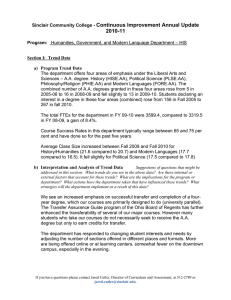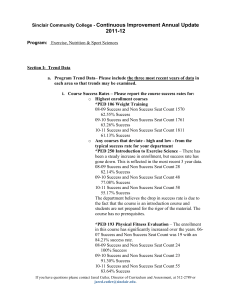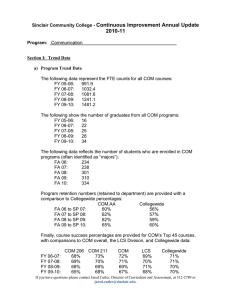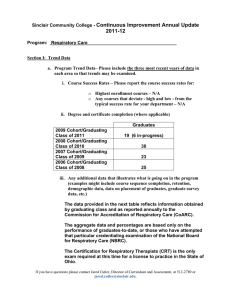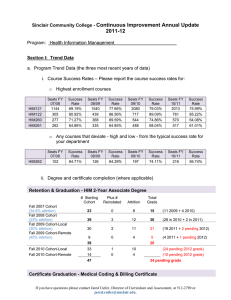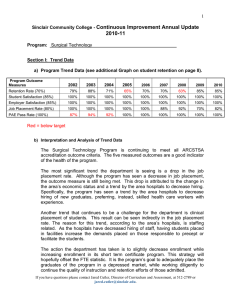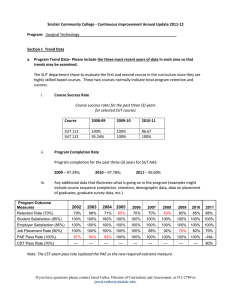Sinclair Community College - Continuous Improvement Annual Update 2010-11 Program:
advertisement
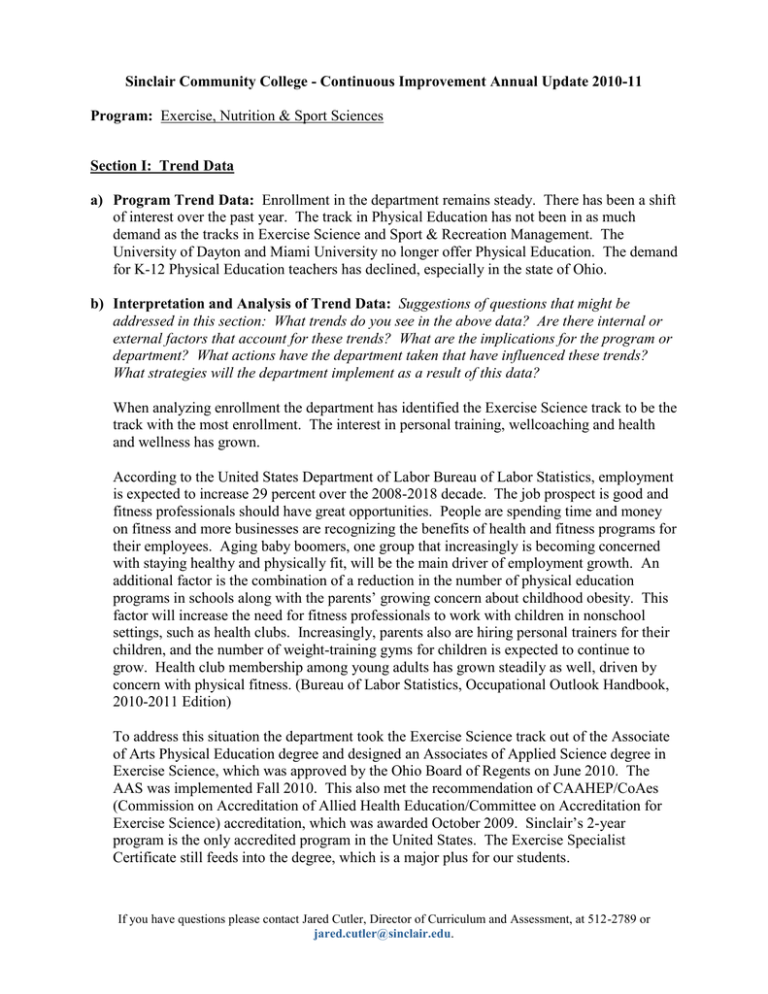
Sinclair Community College - Continuous Improvement Annual Update 2010-11 Program: Exercise, Nutrition & Sport Sciences Section I: Trend Data a) Program Trend Data: Enrollment in the department remains steady. There has been a shift of interest over the past year. The track in Physical Education has not been in as much demand as the tracks in Exercise Science and Sport & Recreation Management. The University of Dayton and Miami University no longer offer Physical Education. The demand for K-12 Physical Education teachers has declined, especially in the state of Ohio. b) Interpretation and Analysis of Trend Data: Suggestions of questions that might be addressed in this section: What trends do you see in the above data? Are there internal or external factors that account for these trends? What are the implications for the program or department? What actions have the department taken that have influenced these trends? What strategies will the department implement as a result of this data? When analyzing enrollment the department has identified the Exercise Science track to be the track with the most enrollment. The interest in personal training, wellcoaching and health and wellness has grown. According to the United States Department of Labor Bureau of Labor Statistics, employment is expected to increase 29 percent over the 2008-2018 decade. The job prospect is good and fitness professionals should have great opportunities. People are spending time and money on fitness and more businesses are recognizing the benefits of health and fitness programs for their employees. Aging baby boomers, one group that increasingly is becoming concerned with staying healthy and physically fit, will be the main driver of employment growth. An additional factor is the combination of a reduction in the number of physical education programs in schools along with the parents’ growing concern about childhood obesity. This factor will increase the need for fitness professionals to work with children in nonschool settings, such as health clubs. Increasingly, parents also are hiring personal trainers for their children, and the number of weight-training gyms for children is expected to continue to grow. Health club membership among young adults has grown steadily as well, driven by concern with physical fitness. (Bureau of Labor Statistics, Occupational Outlook Handbook, 2010-2011 Edition) To address this situation the department took the Exercise Science track out of the Associate of Arts Physical Education degree and designed an Associates of Applied Science degree in Exercise Science, which was approved by the Ohio Board of Regents on June 2010. The AAS was implemented Fall 2010. This also met the recommendation of CAAHEP/CoAes (Commission on Accreditation of Allied Health Education/Committee on Accreditation for Exercise Science) accreditation, which was awarded October 2009. Sinclair’s 2-year program is the only accredited program in the United States. The Exercise Specialist Certificate still feeds into the degree, which is a major plus for our students. If you have questions please contact Jared Cutler, Director of Curriculum and Assessment, at 512-2789 or jared.cutler@sinclair.edu. The Sport and Recreation Management and Physical Education tracks are still intact for the AA degree. We will continue to monitor the enrollment. Section II: Progress Since the Most Recent Review a) What was the fiscal year of the most recent Program Review for this program? 2005-2006 b) Briefly summarize the goals that were listed in Section IV part E of the most recent Program Review Self-Study (this section of the Self-Study asks “What are the department’s/program’s goals and rationale for expanding and improving student learning, including new courses, programs, delivery formats and locations”)? The department has done a wonderful job addressing the items in Section IV part E of the department’s self study to expand and improve student learning. We have added courses that are preparing our students to successfully pass a national exam for personal trainer and group fitness instructor. The department went through a name change going from Physical Education Department to the Exercise, Nutrition & Sport Sciences Department. The Tech Prep Exercise Science Pathway schools continue to grow, going from three schools to six. The Exercise Specialist Certificate will be offered in its entirety Fall 2011 at the Courseview Campus. We also developed the Sport and Recreation Management track which is has seen steady growth. c) Have these goals changed since your last Program Review Self-Study? If so, please describe the changes. The department met most of the goals that were identified in the 2005-2006 Self Study. The biggest accomplishment since the last review is the implementation of the Associates of Applied Science in Exercise Science. The department’s goal or focus now is on a successful quarter to semester conversion. d) What progress has been made toward meeting any of the goals listed above in the past year? The department received approval of the Associates of Applied Science in Exercise Science June 2010. Enrollment for the program started Fall 2010. The department has also completed all courses and programs for the quarter semester conversion. Updating the teaching syllabi will be our next task for this project. e) What Recommendations for Action were made by the review team to the most recent Program Review? What progress has been made towards meeting these recommendations in the past year? The department was asked to consider internal collaboration opportunities such as bringing DIT into the department. That recommendation has been accomplished. We were also asked to monitor the employment outlook and placement for existing program tracks and certifications before adding, which we have done and continue to do on an ongoing basis. It If you have questions please contact Jared Cutler, Director of Curriculum and Assessment, at 512-2789 or jared.cutler@sinclair.edu. has been rewarding to see that the recommendations that were made and met have brought the department student success. Section III: Assessment of Outcomes The Program Outcomes for this program are listed below. At least one-third of your program outcomes must be assessed as part of this Annual Update, and across the next three years all of these program outcomes must be assessed at least once. Exercise, Nutrition and Sport Sciences Program Outcomes 1) Exhibit an understanding of the principles of the biological aspects of life as related to the scientific world. 2) Demonstrate and instruct effectively a wide variety of Physical Education skills and activities and be able to administer a wide variety of fitness evaluation assessments for exercise prescription. In which courses are these program outcomes addressed? Assessment Methods Used PED 270 PED 270 PED 270 PED 270 PED 270 is the internship capstone course. Students will be CPR & First Aid Certified. Students present in their portfolio their personal wellness log. PED 270 3) Show an understanding of personal health concepts. Recognize and correctly treat bodily and/or health related problems with the scope of practice. 4) Explain the significance and importance of physical education/exercise science/sport and recreation management and its impact on society. 5) Identify best practice in physical education/exercise Science/sport and recreation management. Demonstrate an ability to organize and develop a variety of recreation/fitness/ sport programming and events. Which of these program outcomes were assessed during the last fiscal year? a) For the assessment methods listed in the table above, what were the results? What changes are planned as a result of the data? How will you determine whether those changes had an impact? Students will have current American Red Cross certifications. The certifications will include Community First Aid and Safety, Infant, Child and Adult CPR and AED Training. If you have questions please contact Jared Cutler, Director of Curriculum and Assessment, at 512-2789 or jared.cutler@sinclair.edu. We realize we need to have a specific format for the personal wellness documentation. Our plan is to redesign and have all interns use the same format. We will be able to fairly evaluate everyone by using the same template. The information will be gathered to see if the template needs to be adjusted on an ongoing basis. It is important for our future professionals to be role models in shaping others health/fitness/wellness behaviors. b) What other changes have been made in past years as a result of assessment of program outcomes? What evidence is there that these changes have had an impact? Check sheets were formatted and are used in courses that introduce; demonstrate and instruct effectively a wide variety of Physical Education skills and activities and be able to administer a wide variety of fitness evaluation assessments for exercise prescription. The faculty is able to give feedback to the students regarding these outcomes. The same check sheet is used at the student’s internship site to show proficiency of program outcomes. PED 270 Internship is the true capstone course to capture this data. The students have added a short reflection paper regarding their understanding of the “Best Practice” concept in their major. This project has worked well. We believe it has increased the students’ confidence and ability to provide well thought out lesson plans/fitness programs and events. We will continue to monitor to see if the reflection paper is capturing the information that we need for this outcome. The students have also added a short essay to explain the significance and impact Physical Education/Exercise Science or Sport and Recreation Management has on society. This essay is included in the final portfolio; it will reflect an actual experience during the internship. The real world work experiences along with summarizing have been a great way to capture the impact on society outcome. c) Describe general education changes/improvements in your program/department during this past academic year (09-10). General Education outcomes are in all PED courses, no changes at this time. Section IV: Improvement Efforts for the Fiscal Year a) FY 09-10: What other improvement efforts did the department make in FY 09-10? How successful were these efforts? What further efforts need to be made? If your department didn’t make improvement efforts during the fiscal year, discuss the strengths and weaknesses of the department over the last year and how the department plans to address them in the coming year. The department monitors course offerings to enhance student satisfaction and success. The department has added several new activity courses, fencing, Nia technique and TRX suspension training. If you have questions please contact Jared Cutler, Director of Curriculum and Assessment, at 512-2789 or jared.cutler@sinclair.edu. b) FY 10-11: What improvement efforts does the department have planned for FY 10-11? How will you know whether you have been successful? The department would like to explore the possibility of collaboration with Counseling Services. DIT and DEH have implemented their services in a variety of ways that have been helpful to students. Questions regarding completion of the Annual Update? Please contact the Director of Curriculum and Assessment at 512-2789 to schedule a time to review the template and ask any questions. If you have questions please contact Jared Cutler, Director of Curriculum and Assessment, at 512-2789 or jared.cutler@sinclair.edu.
